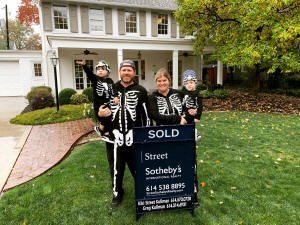The great divergence: U.S. COVID-19 economy has delivered luxury houses
for some, evictions for others
 Send a link to a friend
Send a link to a friend
 [October 31, 2020] By
Michelle Conlin [October 31, 2020] By
Michelle Conlin
(Reuters) - When the temperature dipped
near freezing in Columbus, Ohio in mid-October, the children had no
heat. The gas had been shut off in their apartment for nonpayment. DaMir
Coleman, 8, and his brother, KyMir, 4, warmed themselves in front of the
electric oven.
The power, too, was set to be disconnected. Soon there might be no oven,
no lights and no internet for online schooling. The boys’ mother,
Shanell McGee, already had her cell phone switched off and feared she
could soon face eviction from their $840-a-month apartment. The rundown
unit consumes nearly half her wages from her job as a medical assistant
at a clinic, where she works full-time but gets no health benefits.
Just 14 miles northwest of McGee’s neighborhood, Kiki Kullman is having
one of the best years of her life.
The real-estate business she runs with her family just sold the
highest-priced house in its history: a 13,000-square-foot estate, listed
for $4.5 million, that came with an elevator and a classic-car showroom.
And in late October, Kullman closed on a home of her own -- a $645,000
three-story Colonial, painted a stately white with a front door flanked
by columns, a pleasant place for her two-year-old twin boys to grow up.

Columbus exemplifies the economic split animating America’s coronavirus
crisis.
Professionals like Kullman are thriving, thanks in part to
pandemic-induced policies by the Federal Reserve that have buoyed the
stock market and fueled industries such as real estate with record-low
interest rates.
For many lower-wage workers, meanwhile, the crisis has delivered a cruel
shove, toppling families like the McGees who were already living on the
financial edge. Nationwide, millions of people including hotel workers,
retail clerks, waiters, bartenders, airline employees and other service
workers have lost jobs as COVID-19 fears crushed consumer demand.
Economists call this phenomenon a “K-shaped" recovery, in which those on
the top continue to climb upward while those on the bottom see their
prospects worsen.
Ned Hill, professor of economic development at Ohio State University,
called that downward slope of the K “fat and broad and long and ugly
looking.” He said there’s little hope for a return to normal as long as
coronavirus continues to spread unabated in the United States. In Ohio,
COVID-19 cases are soaring and hit a record of 3,590 new cases on Oct.
29. In Columbus alone, at least 643 people have died.
“People's jobs and incomes have disappeared, and they aren’t coming back
until people’s threat of dying from the virus dissipates,” Hill said.
"That's it."
Located in the center of Ohio, about halfway between Pittsburgh and
Indianapolis, Columbus is a city of some 900,000 people. Home to Ohio
State University and the state's capital, its employment is rooted in
sectors like hospitality, education and health, government, and
professional and business services.
That mix has allowed it to fare better during the crisis than some other
Rust Belt cities that are more heavily dependent on manufacturing.
Columbus’s September unemployment rate of 7.5% was lower than the
national average of 7.9%. But like the rest of the United States, its
front-line and modestly skilled workers have been slammed the hardest.
The divergence of fortune can be seen in the city’s housing market.

For those with means, like the clients of real estate agent Kullman, low
interest rates have translated into cheaper mortgages, allowing them to
afford bigger houses. Columbus is just one of four U.S. cities - along
with Cincinnati, Kansas City and Indianapolis - where houses are selling
in less than five days on average, according to real estate research
firm Zillow.
“It is crazy to see in Columbus the million-plus price point getting
multiple offers and all-cash bids,” said Kullman, 36.
For renters hammered by the downturn, meanwhile, housing is a precarious
business.
During the early days of the pandemic as Ohio’s residents sheltered in
place, evictions in Columbus fell, thanks to local and federal
protections to keep renters in their homes. But since September, 1,774
eviction cases have been filed, far surpassing summer levels, according
to Princeton University’s Eviction Lab, which tracks evictions. The
Greater Columbus Convention Center now serves as a bustling eviction
court.
Those filings came despite a Sept. 4 decree by the U.S. Centers for
Disease Control and Prevention (CDC) banning all evictions nationwide
until Jan. 1 to prevent a surge of newly homeless people from
contracting and spreading the coronavirus. Under the moratorium,
landlords cannot evict tenants who can no longer pay rent because their
earnings have been affected by COVID-19.
But landlords are not required to inform tenants of these protections
and are free to file eviction lawsuits. Only renters who know about the
CDC ban, qualify for it and take legal action to assert their rights can
stop their evictions. Among the 24 cities the Eviction Lab tracks,
Columbus is one of the few where evictions did not fall after the ban.
[to top of second column] |

Kiki and Greg Kullman with their twin boys, Cam and Kyle pose in
Columbus, Ohio, U.S. in this undated handout picture. Courtesy of
the Kullman family/Handout via REUTERS

The fallout can be seen across Columbus. The local pot of money from federal
relief to help cash-strapped tenants pay rent was tapped out in September. Food
banks are running low on staples, and homeless shelters are at capacity,
according to community advocates.
Utility shut-offs have surged to the point that lawyers for the Legal Aid
Society of Columbus have resorted to filing personal bankruptcy petitions for
tenants to keep their heat, lights and water on.
If present conditions persist, and without a new round of federal relief, as
many as 40 million people could be at risk of eviction in coming months,
according to the Aspen Institute, a think tank. In a typical year, 3.6 million
eviction cases are filed.
'BEING POOR COSTS YOU'
Even before the pandemic, McGee, 29, was struggling financially. In 2014, she
bought a 2008 Chevy Malibu off a corner lot charging 22% interest. She said the
junker stopped running long ago, so she stopped paying in 2016. McGee said she
offered to return the vehicle, which has 176,475 miles on it, but the lender
wouldn't take it back.
In March, McGee’s live-in boyfriend lost his job at a fast-food restaurant as
Ohio went on lockdown, cutting their household's income. In August, he was
diagnosed with COVID-19 and the entire family had to quarantine. That same week,
McGee got a call from her employer, telling her that her lender had gotten a
court order to garnish 25% of her wages to repay more than $10,000, with
penalties and late fees, that she still owed on the car.
That left her with take-home pay of $728 every two weeks. She couldn't afford
school supplies for her sons and had to borrow gas money from her mom to get to
work in her boyfriend's car.
“It was heartbreaking, it was everything all at once,” said McGee, who wears
rectangular glasses and has a broad, easy smile.
She sought help from Paul Bryson, an attorney with the Legal Aid Society who
filed a bankruptcy petition in October to get McGee’s utilities turned back on
and the garnishment frozen. The court approved the petition, but not before
McGee's lender took $1,023 of her wages.

“Being poor costs you a lot of money,” Bryson said. “Even before the pandemic,
somebody’s entire life falls apart when they get a garnishment. And now? If
nothing is done, we are just going to have a lot of people on the street.”
McGee’s car lender, Columbus Mortgage, did not respond to requests for comment.
LIVING THE DREAM
For years, Kullman, the real estate agent, fantasized about living on Bedford
Road, a coveted address in the Columbus suburbs.
In the region's poshest neighborhoods, sumptuous houses that make perfect
pandemic compounds, with amenities like his-and-hers home offices and roomy
basements for online schooling, can sell in a day, often with multiple offers in
all-cash deals well above the asking price. Kullman said some shoppers are
submitting bids without ever touring a house. The most desperate are agreeing to
“no-remedy” inspections, meaning they won’t ask for concessions if the
inspection turns up a major defect. Others, she said, have authorized “crazy
escalation clauses with no cap.” In real estate parlance, that means they will
beat any other offer, no matter how high the price.
“You have to sign away your life to get the house you want,” Kullman said.
In August, Kullman, who runs the Kullman Group at Street Sotheby’s International
with her husband, father and sister, found out that a couple who lived on
Bedford Road were about to move. She made a bid before the house hit the market
and the owners accepted. The Colonial is right next door to her sister’s home;
their kids will share backyards.
Kullman is aware of her good fortune amidst the pandemic, and the mean hand that
coronavirus has dealt to the city’s most vulnerable.
Her husband has been doing business with a landlord who’s selling a portfolio of
homes in Columbus’s low-income neighborhood of Linden. Non-paying tenants in
those properties have been getting eviction notices.

“It is night and day, what we see here,” Kullman said. “Which is not what you
would expect in COVID. It’s sad but it’s true.”
(Reporting By Michelle Conlin in New York; Editing by Tom Lasseter and Marla
Dickerson)
[© 2020 Thomson Reuters. All rights
reserved.] Copyright 2020 Reuters. All rights reserved. This material may not be published,
broadcast, rewritten or redistributed.
Thompson Reuters is solely responsible for this content. |